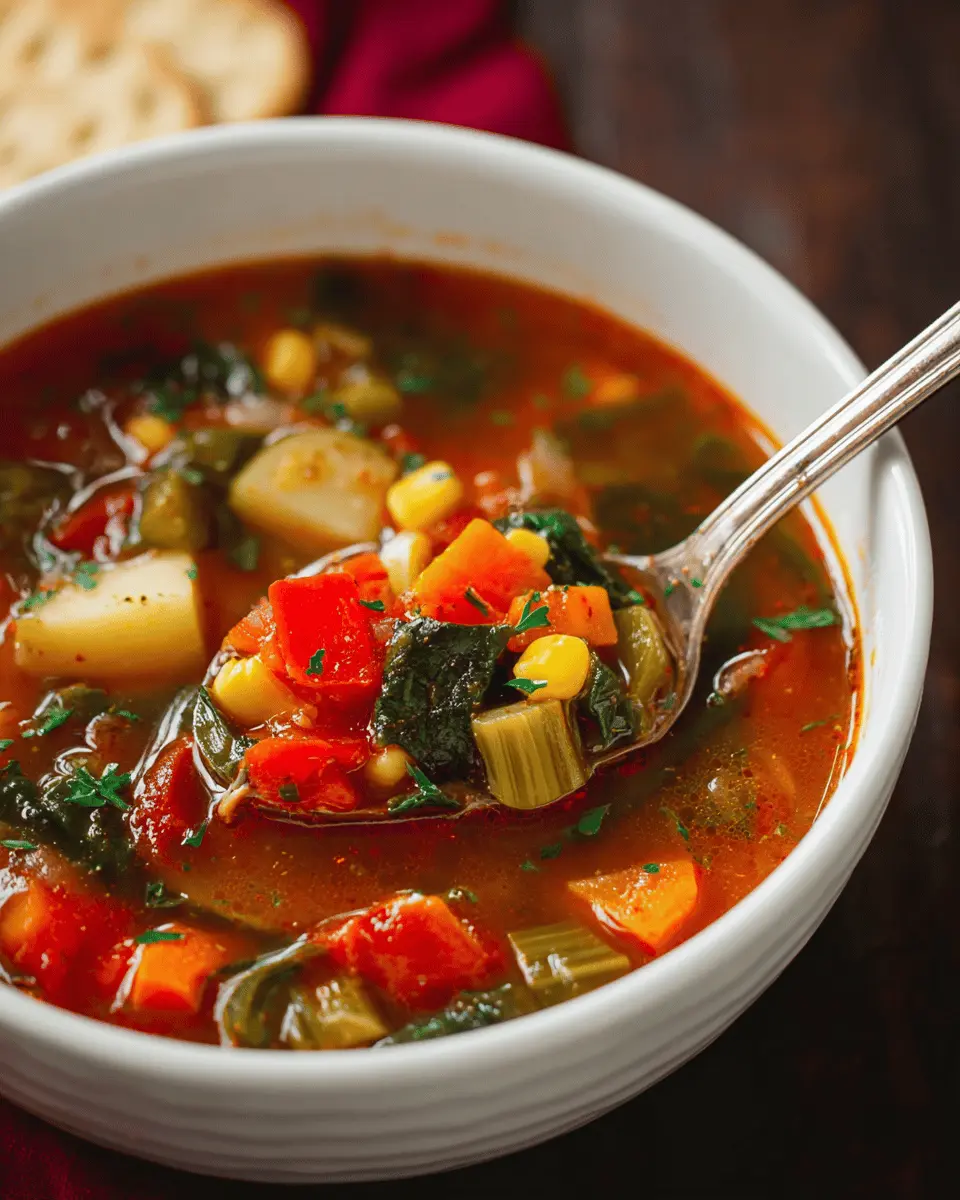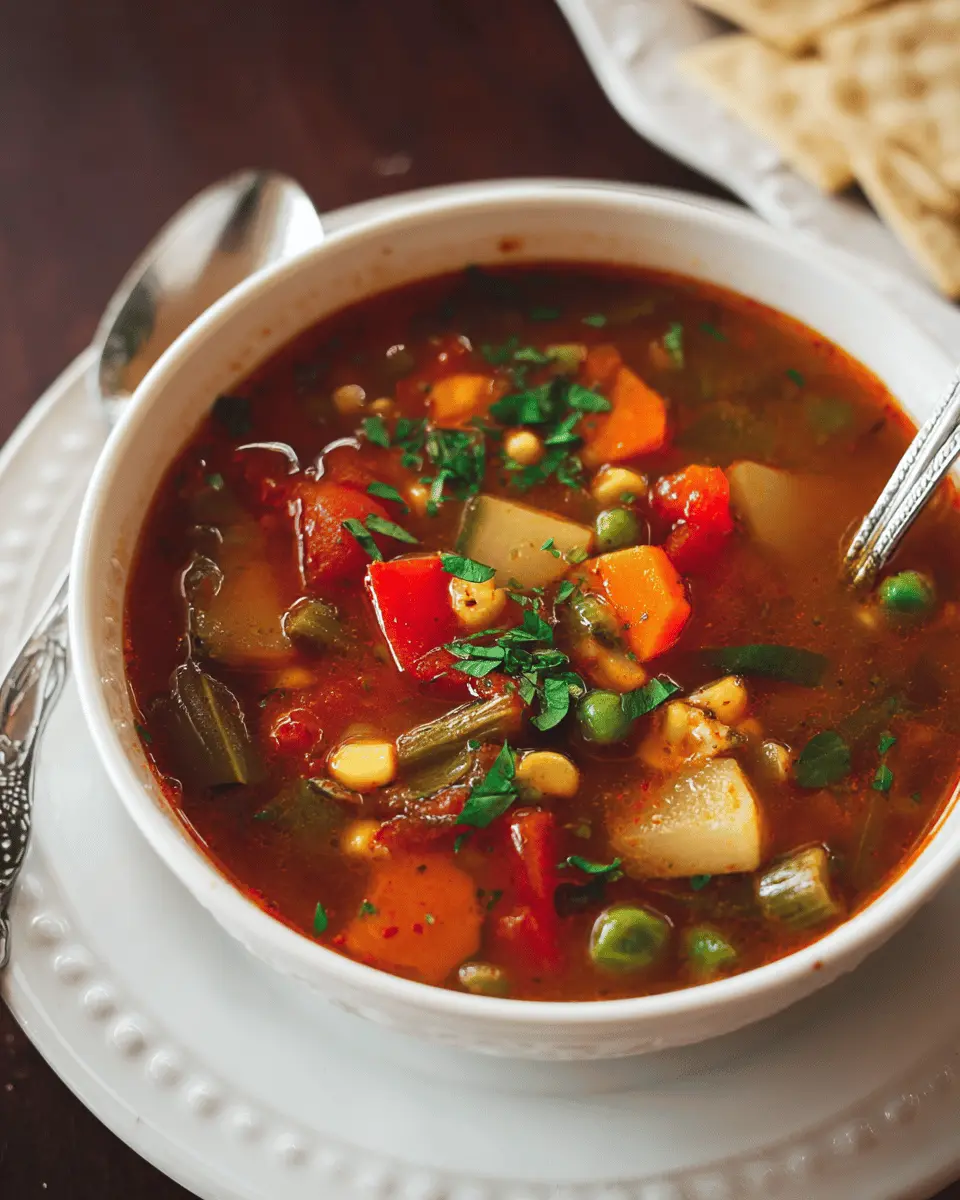Introduction to Vegetable Soup
Vegetable soup is more than just a comforting dish; it’s a lifesaver for busy young professionals. When time is tight and you’re juggling work deadlines, social obligations, and self-care, a hearty bowl of vegetable soup can be a quick and nutritious meal option. It’s packed with vitamins and minerals, making it an excellent choice for maintaining energy levels throughout the day.
Why Vegetable Soup is a Go-To for Young Professionals
The beauty of vegetable soup lies in its versatility and ease of preparation. With just a handful of ingredients, you can whip up a healthy meal in under an hour. Not only is it budget-friendly, but it also allows you to get creative with whatever vegetables you have on hand. You can experiment with seasonal produce, and it’s a great way to minimize food waste.
Did you know that making your soups can significantly reduce sodium intake compared to store-bought options? Additionally, you have full control over what goes into your bowl, ensuring you stay aligned with your dietary goals.
So, whether you're meal-prepping for the week or looking to impress friends at a cozy night in, this vegetable soup recipe is your ticket to a delicious, healthy meal that checks all the boxes. Get ready to savor every spoonful!

Ingredients for Vegetable Soup
Creating a delicious vegetable soup begins with the right selection of ingredients. Here are the essentials you’ll want to gather for a flavorful bowl of wholesome goodness.
Essential Fresh Vegetables
Start with vibrant, fresh vegetables that form the backbone of your soup:
- Onion - 1 ½ cups of chopped yellow onion (around one medium-sized onion)
- Carrots - 2 cups peeled and chopped (approximately 5 medium carrots)
- Celery - 1 ¼ cups chopped (about 3 stalks)
- Garlic - 4 cloves minced, for an aromatic kick
- Potatoes - 3 cups diced (from about 3 medium potatoes) for heartiness
- Green Beans, Corn, and Peas - 1 ½ cups green beans, 1 ¼ cups corn, and 1 cup peas add vibrant colors and textures.
Broth and Seasoning Ingredients
The base of your vegetable soup is crucial:
- Broth - 4 cans of low-sodium chicken or vegetable broth for depth of flavor
- Diced Tomatoes - 2 cans (undrained) for added richness
- Herbs and Spices - 2 bay leaves, ½ teaspoon dried thyme or 1 tablespoon fresh, along with salt and pepper to taste.
Optional Flavor Boosters
Want to elevate your soup further? Consider these add-ins:
- Fresh or dried herbs like basil, oregano, or rosemary for an aromatic touch.
- A parmesan rind for umami richness, easily removed after cooking.
- A splash of fresh lemon juice or apple cider vinegar at the end for brightness.
With these ingredients, you're well on your way to crafting a vegetable soup that’s not only nourishing but also downright delicious! For more insights, check out resources on seasonal vegetables from LocalHarvest or explore flavor pairings with The Flavor Bible. Happy cooking!
Preparing Vegetable Soup
Creating a delicious and nutritious vegetable soup is a wonderful way to nurture your body and soul. This hearty dish not only embodies warmth but is also a great opportunity to explore the plethora of colorful veggies available. Let’s walk through the simple steps to bring this comforting bowl to life.
Gather Your Ingredients
Before you dive into cooking, it’s best to prepare by gathering all your ingredients. Here’s what you’ll need:
- 2 tablespoon olive oil
- 1 ½ cups chopped yellow onion (about 1 medium onion)
- 2 cups peeled and chopped carrots (approximately 5)
- 1 ¼ cups chopped celery (around 3 stalks)
- 4 cloves garlic, minced
- 4 (14.5 oz) cans of low-sodium chicken broth or vegetable broth
- 2 (14.5 oz) cans of diced tomatoes (undrained)
- 3 cups peeled and diced potatoes (about 3 medium potatoes)
- ⅓ cup chopped fresh parsley
- 2 bay leaves
- ½ teaspoon dried thyme (or 1 tablespoon fresh thyme)
- Salt and freshly ground black pepper, to taste
- 1 ½ cups chopped green beans (frozen or fresh)
- 1 ¼ cups frozen or fresh corn
- 1 cup frozen or fresh peas
Having everything ready will make your cooking process smoother and more enjoyable. If you're unsure about where to buy fresh produce, check out your local farmer's market for the best selection.
Sauté the Aromatics
Now that you've prepped your ingredients, it’s time for the aroma to fill your kitchen. Heat the olive oil in a large pot over medium-high heat. Once hot, add in the onions, carrots, and celery. Sauté these for about 4 minutes until they begin to soften, then add in the minced garlic and sauté for another 30 seconds. This step really enhances the vegetable soup with depth and flavor!
Combine Broth and Vegetables
Next, pour in your broth and add the undrained diced tomatoes, diced potatoes, parsley, bay leaves, thyme, and a pinch of salt and pepper. The combination of flavors here is where the magic happens. Stir it all together and let those ingredients get to know each other.
Bring to a Boil and Simmer
Bring your mixture to a rolling boil. Once it’s bubbling away, toss in the green beans. Reduce the heat to medium-low, cover the pot, and let it simmer for about 20 to 30 minutes, or until the potatoes are almost tender. This simmering process creates a rich and hearty base for your soup comparable to any restaurant-quality dish.
Add in the Final Veggies
In the final stages, introduce the corn and peas to the pot, simmering for an additional 5 minutes. This is the moment when your vegetable soup bursts with life and color. The variety of textures and flavors is sure to delight your palate!
And there you have it! A wholesome, vibrant vegetable soup that warms the heart and satisfies the soul. Whether you’re enjoying it with crusty bread or on its own, this recipe is bound to become a cherished favorite in your kitchen.

Variations on Vegetable Soup
Hearty minestrone-style vegetable soup
If you're in the mood for a heartier meal, try a minestrone-style vegetable soup. Just throw in some cooked pasta, a variety of beans like cannellini or kidney, and even some leafy greens such as kale or spinach. The robust flavors from these additions make it a filling option that’s perfect for chilly evenings. Plus, it packs a nutritional punch! For tips on more creative bean recipes, check out this article on legumes.
Creamy vegetable soup alternatives
Looking to elevate your vegetable soup experience? Blend a portion of the soup until creamy before serving. You can also add a splash of coconut milk or cream for richness. This version not only satiates your hunger but also warms your soul—ideal for winding down after a long day. Want tantalizing tips on creating silky textures? Visit Bon Appétit’s guide on creamy soups.
Cooking Tips and Notes for Vegetable Soup
Enhancing Flavors with Herbs and Spices
To elevate your vegetable soup, consider adding a variety of herbs and spices. Fresh herbs like basil or thyme can transform your soup into a flavor powerhouse. Dried herbs, such as oregano and rosemary, are excellent too. Don't be afraid to experiment—try mixing in a tablespoon of your favorite seasoning blends or even a splash of lemon juice for brightness.
Best Practices for Using Fresh vs. Frozen Vegetables
Both fresh and frozen vegetables work wonders in a vegetable soup, but they each bring unique benefits. Fresh veggies add vibrant color and texture, while frozen vegetables are often picked at peak ripeness and can save prep time. If using fresh, chop them into uniform pieces for even cooking. For frozen, simply toss them in without thawing to maintain their nutrients. Check out resources from the USDA for more on the benefits of vegetables in your diet and how to store them properly!
By following these tips, you're well on your way to creating a vegetable soup that’s both delicious and comforting!

Serving suggestions for Vegetable Soup
Toppings that elevate your soup
Transform your vegetable soup into a gourmet experience! Consider adding:
- Grated Parmesan: A sprinkle adds richness and a savory finish.
- Fresh Herbs: Chopped basil, dill, or chives can bring brightness.
- Croutons: For a delightful crunch, homemade or store-bought croutons work wonders.
- Avocado: Diced avocado on top gives creamy texture and healthy fats.
- A drizzle of Olive Oil: A splash elevates the flavor profile beautifully.
Pairing ideas for a complete meal
To make your meal truly satisfying, pair your vegetable soup with:
- Crusty Bread or Garlic Bread: Perfect for dipping and soaking up delicious flavors.
- Simple Salad: A light spinach or mixed greens salad adds freshness.
- Grilled Cheese Sandwich: A classic combination that never disappoints!
- Turkey Bacon or Chicken Ham Wraps: For a protein boost, these wraps bring depth and heartiness.
These suggestions not only enhance your vegetable soup but also create a nourishing meal that you'll love! For more creative recipes or tips, consider checking out Serious Eats or Food Network for inspiration.
Time breakdown for Vegetable Soup
Preparation time
Getting ready for this comforting vegetable soup takes just 15 minutes. Chop your veggies, measure the ingredients, and you’ll be all set to start cooking.
Cooking time
The actual cooking will take about 40 minutes, where the magic happens. You’ll sauté, simmer, and let those flavors meld beautifully.
Total time
In just 55 minutes, you can have a warm pot of vegetable soup ready to serve! Perfect for a cozy evening or meal prep for the week ahead.
For more tips on making the best out of your soup night, check out this guide on seasonal vegetables. It can help you choose the freshest ingredients!
Nutritional facts for Vegetable Soup
Caloric content
This hearty vegetable soup packs approximately 150 calories per serving. That’s perfect for a guilt-free meal, especially on those busy weeknights when you need something nutritious and satisfying.
Key vitamins and minerals
Each bowl is brimming with essential vitamins and minerals. You can expect a healthy dose of vitamin A from carrots, vitamin C from tomatoes, and plenty of potassium from potatoes. Plus, the fiber from the various veggies can help support digestive health and keep you feeling fuller longer.
For a deeper dive into vegetable nutrition, be sure to check out the USDA's FoodData Central for detailed information.
FAQs about Vegetable Soup
How can I make my vegetable soup even healthier?
Looking to elevate your vegetable soup game? Consider adding dark leafy greens like kale or spinach for extra nutrients. You can also sneak in legumes, such as lentils or chickpeas, to boost protein and fiber content. Using low-sodium broth helps in trimming down on unnecessary salt while maintaining flavor. For added brightness, a squeeze of lemon juice just before serving can do wonders!
What's the best way to store leftover vegetable soup?
To keep your vegetable soup fresh, allow it to cool completely before transferring it to an airtight container. Refrigerate it for up to 5 days. When storing, consider portioning it into smaller containers for easy access—a great trick for quick lunches or dinners.
Can I freeze vegetable soup, and for how long?
Absolutely! Freezing is a fantastic option for your vegetable soup. Just ensure it’s cooled down completely before placing it in freezer-safe containers. Properly stored, your soup can last for up to 3 months. When ready to enjoy, thaw it in the refrigerator overnight, then heat it on the stovetop or microwave until warmed through.
Conclusion on Vegetable Soup
This vegetable soup is a comforting, nutritious option perfect for any meal. Packed with vibrant veggies and wholesome ingredients, it's sure to please everyone at your table. Whether enjoyed alone or paired with crusty bread, this soup is a delightful addition to your culinary repertoire. Give it a try!

Vegetable Soup
Equipment
- large pot
Ingredients
Vegetables and Broth
- 2 tablespoon olive oil
- 1.5 cups chopped yellow onion (1 medium)
- 2 cups peeled and chopped carrots (about 5)
- 1.25 cups chopped celery (about 3)
- 4 cloves garlic minced
- 4 14.5 oz cans low-sodium chicken broth or vegetable broth
- 2 14.5 oz cans diced tomatoes undrained
- 3 cups peeled and ½-inch thick diced potatoes (from about 3 medium)
- ⅓ cup chopped fresh parsley
- 2 bay leaves
- 0.5 teaspoon dried thyme or 1 tablespoon fresh thyme leaves
- Salt and freshly ground black pepper to taste
- 1.5 cups chopped frozen or fresh green beans
- 1.25 cups frozen or fresh corn
- 1 cup frozen or fresh peas
Instructions
Cooking Steps
- Heat olive oil in a large pot over medium-high heat.
- Add onions, carrots, and celery and sauté for 4 minutes, then add garlic and sauté for 30 seconds longer.
- Add in broth, tomatoes, potatoes, parsley, bay leaves, thyme, and season with salt and pepper to taste.
- Bring to a boil, then add green beans.
- Reduce heat to medium-low, cover, and simmer until potatoes are almost fully tender, about 20 - 30 minutes.
- Add corn and peas and cook for 5 minutes longer. Serve warm.





Leave a Reply